Letter of rejected goods due to quality issues: Free template

Letter of rejected goods due to quality issues
A notification letter of rejected goods due to quality issues is a formal communication used to inform a supplier or vendor that delivered goods do not meet agreed-upon quality standards or specifications. This letter outlines the specific issues, references the relevant agreement or standards, and requests corrective action or next steps.
How to use this letter of rejected goods due to quality issues
- Open with an introduction: Address the recipient respectfully and reference the delivery of goods in question, including relevant details such as the delivery date, order number, or invoice reference.
- State the rejection: Clearly communicate that the goods have been rejected due to quality issues, specifying that they do not meet agreed-upon standards or specifications.
- Provide details: Outline the specific quality issues identified, such as defects, inconsistencies, or deviations from specifications. Include evidence, such as inspection reports, photographs, or test results, if applicable.
- Reference the agreement: Mention the relevant contract terms, purchase order, or agreed standards that the goods failed to meet.
- Request corrective action: Specify the next steps, such as replacement goods, a refund, or reinspection, and include a deadline for resolution.
- Emphasize compliance: Reiterate your commitment to maintaining quality standards and the importance of adherence to the agreed terms.
- Maintain a professional tone: Ensure the letter is clear, respectful, and focused on resolving the issue constructively.
- Provide contact information: Include details for the recipient to reach out with questions or discuss the matter further.
Benefits of using a letter of rejected goods due to quality issues
This letter ensures a structured and professional way to communicate quality concerns while fostering accountability and resolution. Here’s how it helps:
- Promotes clarity: Clearly outlining quality issues helps the supplier understand the problem and take appropriate action.
- Reflects professionalism: A well-crafted letter demonstrates respect and commitment to quality standards.
- Encourages accountability: Documenting the rejection emphasizes the importance of meeting agreed-upon terms.
- Supports resolution: Providing actionable next steps ensures a constructive path forward.
- Preserves relationships: Maintaining a respectful tone fosters goodwill for future collaboration.
Tips for writing an effective letter of rejected goods due to quality issues
- Be specific: Clearly describe the quality issues, referencing relevant standards or agreements.
- Use professional language: Maintain a respectful and constructive tone to encourage cooperation.
- Provide evidence: Include documentation, such as photos or test results, to substantiate the rejection.
- Highlight next steps: Specify corrective actions required, such as replacement, refund, or reinspection.
- Include a timeline: Provide a deadline for resolving the issue to ensure timely action.
- Keep it concise: Focus on the key points while ensuring the tone is professional and solution-oriented.
Frequently asked questions (FAQs)
Q: What details should I include in this letter?
A: Include the order reference, description of the quality issues, relevant agreement terms, and requested corrective actions.
Q: Should I personalize the letter?
A: Yes, addressing the recipient by name and referencing specific details of the delivery demonstrates attentiveness.
Q: Who typically sends this letter?
A: Procurement managers, quality assurance teams, or organizational representatives typically send this letter.
Q: How formal should this letter be?
A: The tone should be professional and respectful, focusing on fostering resolution and maintaining the relationship.
Q: When should this letter be sent?
A: Send the letter promptly after identifying quality issues to ensure timely corrective action.
Q: Can this letter include a request for compensation?
A: Yes, if applicable, including a request for compensation or cost adjustment is appropriate.
Q: Is acknowledgment from the recipient required?
A: While not mandatory, requesting acknowledgment ensures the recipient is aware of and addressing the issue.
This article contains general legal information and does not contain legal advice. Cobrief is not a law firm or a substitute for an attorney or law firm. The law is complex and changes often. For legal advice, please ask a lawyer.


